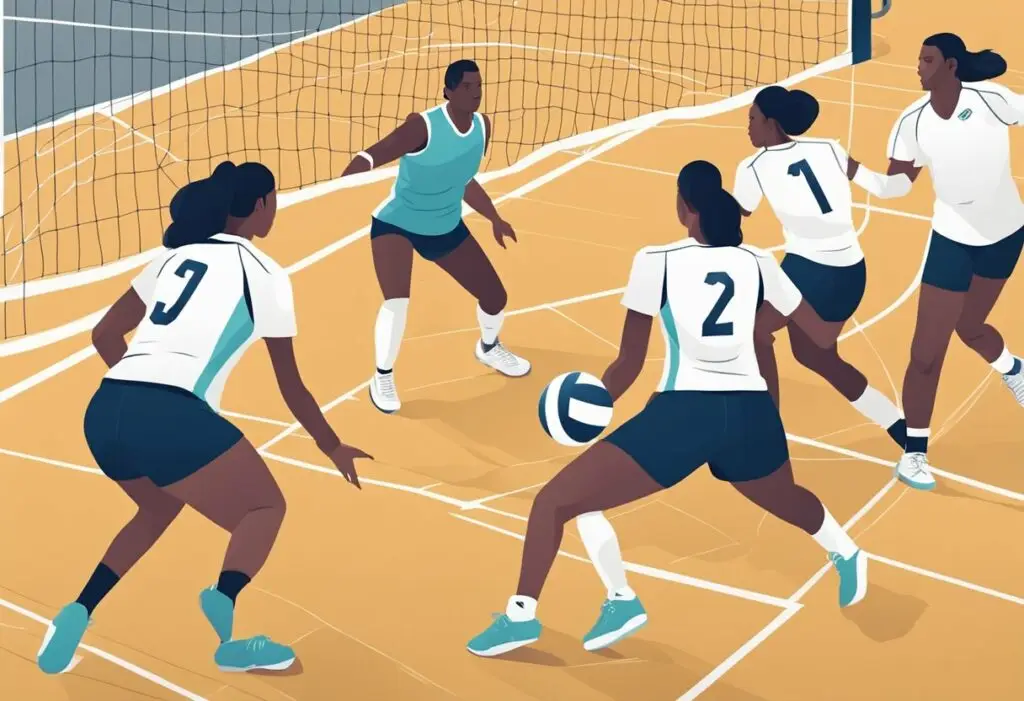The 5-1 volleyball rotation is a popular offensive strategy used by many teams. In this formation, one player acts as the setter and rotates around the court, while the other five players take on the role of hitters.
This formation allows for more creativity and consistency in setting and attacking. It also provides each player with a defined role, which can help to improve team communication and coordination.

To effectively run a 5-1 volleyball rotation, it is important to understand the basics of the formation, including the starting formation, offensive and defensive strategies, and player roles and responsibilities.
Teams must also be able to transition smoothly between rotations and correct common mistakes that can occur during gameplay.
Drills can be used to improve the 5-1 rotation and help players develop advanced techniques and tips.
Key Takeaways
- The 5-1 volleyball rotation is an offensive strategy that uses one setter and five hitters.
- To effectively run a 5-1 rotation, teams must understand the basics of the formation, including player roles and responsibilities, offensive and defensive strategies, and common mistakes and corrections.
- Drills can be used to improve the 5-1 rotation and help players develop advanced techniques and tips.
Basics of the 5-1 Volleyball Rotation

Rotation Fundamentals
The 5-1 volleyball rotation is an offensive system that involves five hitters and one setter.
The system is designed to provide a versatile offense and a consistent setting pattern. The rotation is named after the number of hitters and setters on the court.
The system is widely used in volleyball teams worldwide due to the rules of the Fédération Internationale de Volleyball (FIVB), which limit teams to six substitutions per set, and a player who has been subbed in and then out during a set is unable to return to the court during the same set (Gold Medal Squared).
The 5-1 rotation is more difficult for beginners to learn than the 6-2/4-2 because you have six serve receive rotations to learn as opposed to just three. However, with practice, the 5-1 rotation can be a very effective offensive system.
Positional Responsibilities
In the 5-1 rotation, the setter is responsible for setting up plays, while the hitters focus on attacking.
The setter also has to block, which isn’t necessarily a disadvantage, especially if the team has a tall athletic setter.
The other five players have specific positional responsibilities.
The three front-row players are responsible for attacking and blocking, while the two back-row players are responsible for passing and defending.
The player in the back-right position is usually the team’s libero, who is a defensive specialist and not an attacker.
Starting Positions in 5-1 Volleyball Rotation

In a 5-1 volleyball rotation, there is one dedicated setter who rotates around the entire court, setting in both the front court and back court.
The other five players consist of three hitters and two defensive specialists.
The starting formation is crucial to the success of the team, as it sets the tone for the rest of the game.
Rotation 1: Server in Position 1
In Rotation 1, the server is in Position 1. The setter is in Position 2, while the two outside hitters are in Position 4 and Position 5. The opposite hitter is in Position 1, and the two defensive specialists are in Position 6 and Position 5.
Rotation 2: Server in Position 6
In Rotation 2, the server is in Position 6. The setter is in Position 1, while the two outside hitters are in Position 4 and Position 5. The opposite hitter is in Position 2, and the two defensive specialists are in Position 6 and Position 5.
Rotation 3: Server in Position 5
In Rotation 3, the server is in Position 5. The setter is in Position 1, while the two outside hitters are in Position 2 and Position 4. The opposite hitter is in Position 5, and the two defensive specialists are in Position 6 and Position 1.
Rotation 4: Server in Position 4
In Rotation 4, the server is in Position 4. The setter is in Position 1, while the two outside hitters are in Position 2 and Position 5. The opposite hitter is in Position 6, and the two defensive specialists are in Position 5 and Position 1.
Rotation 5: Server in Position 3
In Rotation 5, the server is in Position 3. The setter is in Position 1, while the two outside hitters are in Position 5 and Position 6. The opposite hitter is in Position 4, and the two defensive specialists are in Position 2 and Position 1.
Rotation 6: Server in Position 2
In Rotation 6, the server is in Position 2. The setter is in Position 1, while the two outside hitters are in Position 5 and Position 6. The opposite hitter is in Position 3, and the two defensive specialists are in Position 4 and Position 1.
It is important to note that the starting formation may change depending on the strengths and weaknesses of the team. The coach may choose to make adjustments to the formation to better suit the team’s needs.
Offensive Strategies in 5-1 Volleyball Rotation

Front Row Attacks
In the 5-1 volleyball rotation, the front row players are responsible for attacking the ball.
The setter is also in the front row for three rotations, which gives the team an advantage in terms of offensive options.
The front row players should be able to perform a variety of attacks, including spikes, tips, and blocks.
The setter can also attack the ball, which can catch the opposing team off guard.
To maximize the effectiveness of the front row attacks, the team should focus on good passes and sets.
The setter should be able to quickly and accurately set the ball to the front row players, who should be ready to attack.
The front row players should also be able to read the opposing team’s defense and adjust their attacks accordingly.
Back Row Attacks
In the 5-1 volleyball rotation, the back row players are responsible for defense and serve receive.
However, they can also contribute to the team’s offense with back row attacks.
Back row attacks can catch the opposing team off guard and result in points for the team.
To execute back row attacks effectively, the back row players should have good ball control and be able to jump and attack the ball from behind the attack line.
The setter should also be able to quickly and accurately set the ball to the back row players, who should be ready to attack.
Quick Sets and Combos
The 5-1 volleyball rotation allows for a variety of quick sets and combos that can result in points for the team.
Quick sets involve the setter quickly setting the ball to a front row player who then attacks the ball before the opposing team has a chance to set up their defense.
Combos involve two or more players working together to confuse the opposing team’s defense and create scoring opportunities.
To execute quick sets and combos effectively, the team should have good communication and timing.
The setter should be able to quickly recognize when a quick set or combo is possible and set the ball accordingly. The front row players should also be able to quickly adjust their positioning and attack the ball.
Defensive Strategies in 5-1 Volleyball Rotation

Blocking Schemes
In the 5-1 volleyball rotation, the blocking scheme is crucial to the team’s success.
The blockers need to work together to form a solid wall at the net and prevent the opposing team from scoring.
The most common blocking scheme used in the 5-1 rotation is the double block.
This involves two players working together to block the opposing team’s hitter.
Another blocking scheme that can be used is the triple block. This is when three players work together to block the hitter.
This can be effective against a particularly strong hitter, but it also leaves the back row open for attacks.
Coaches should carefully consider the strengths and weaknesses of their team and the opposing team before deciding on a blocking scheme.
Defensive Coverage
In the 5-1 volleyball rotation, the defensive coverage is equally important as the blocking scheme.
The defensive players need to be positioned correctly to cover the court and prevent the opposing team from scoring.
The most common defensive coverage used in the 5-1 rotation is the perimeter defense.
This involves the back row players positioning themselves around the perimeter of the court to cover any attacks from the opposing team.
Another defensive coverage that can be used is the rotation defense.
This is when the back row players shift their positions based on the location of the setter.
This can be effective against teams with strong hitters in specific areas of the court.
Coaches should work with their teams to determine the best defensive coverage based on the strengths and weaknesses of the team and the opposing team.
Transitioning Between Rotations

From Serve-Receive to Offense
Transitioning from serve-receive to offense is a crucial part of the 5-1 volleyball rotation.
The team must be able to quickly and efficiently move from the serve-receive formation to the offensive formation to take advantage of any scoring opportunities.
The first step in transitioning from serve-receive to offense is to ensure that the players are in the correct positions.
The setter should be in position to set the ball, and the hitters should be in position to attack.
The team should also be aware of the opposing team’s defensive formation to adjust their own offensive formation accordingly.
The second step is to communicate effectively. The setter should call out the play and the hitters should communicate with the setter to ensure that the ball is set to the correct location.
The team should also communicate any changes in the play or formation.
From Defense to Offense
Transitioning from defense to offense is another crucial part of the 5-1 volleyball rotation.
The team must be able to quickly and efficiently move from the defensive formation to the offensive formation to take advantage of any scoring opportunities.
The first step in transitioning from defense to offense is to ensure that the players are in the correct positions.
The setter should be in position to set the ball, and the hitters should be in position to attack.
The team should also be aware of the opposing team’s defensive formation to adjust their own offensive formation accordingly.
The second step is to communicate effectively. The libero should call out the pass and the setter should call out the play.
The hitters should communicate with the setter to ensure that the ball is set to the correct location.
The team should also communicate any changes in the play or formation.
Overall, transitioning between rotations in the 5-1 volleyball rotation requires effective communication and awareness of the opposing team’s formation.
5-1 Volleyball Rotation: Mistakes and Corrections

Overlap Violations
One of the most common mistakes in the 5-1 volleyball rotation is overlap violations.
This happens when a player rotates to a new position before the player they are replacing has completely left the court.
Overlap violations result in a loss of points and serve, and can be frustrating for players and coaches alike.
To avoid overlap violations, players should communicate with each other and make sure they are aware of their positions on the court.
Coaches can also help by emphasizing the importance of timing and positioning during practice drills.
Timing Errors
Another common mistake in the 5-1 volleyball rotation is timing errors.
This happens when a player is late or early in their movement to a new position on the court.
Timing errors can result in missed opportunities for hits and blocks, and can also lead to overlap violations.
To correct timing errors, players should focus on their footwork and practice moving quickly and efficiently to their new positions.
Coaches can also emphasize the importance of timing and positioning during practice drills, and provide feedback on player movement and positioning.
Player Roles in the 5-1 Volleyball Rotation

In a 5-1 volleyball rotation, each player has a specific role and responsibility on the court.
Clear roles and responsibilities can lead to better team communication and coordination, which can ultimately result in better performance.
Setter
The setter is the most important player in a 5-1 rotation. They are responsible for setting up the hitters and running the offense.
The setter must have excellent ball control, and decision-making skills, and be able to read the defense.
They should also be able to communicate effectively with their teammates and adjust their sets based on the situation.
Outside Hitters
There are two outside hitters in a 5-1 rotation. They are responsible for attacking from the left side of the court and playing defense in the back row.
Outside hitters must be able to pass, hit, and block effectively.
They should also be able to communicate with the setter and middle blockers to coordinate their attacks.
Middle Blockers
There are two middle blockers in a 5-1 rotation. They are responsible for blocking and attacking from the middle of the court.
Middle blockers must have excellent blocking skills and be able to read the opposing team’s offense.
They should also be able to coordinate with the setter and outside hitters to run effective attacks.
Opposite Hitter
The opposite hitter is responsible for attacking from the right side of the court. They must be able to hit and block effectively and should have good communication skills to coordinate with the setter and other hitters.
The opposite hitter is also responsible for playing defense in the back row.
Libero
The libero is a defensive specialist who is responsible for passing and playing defense in the back row.
They are not allowed to attack or block, but they can serve. The libero must have excellent ball control and be able to read the opposing team’s offense. They should also be able to communicate effectively with their teammates to coordinate their defense.
Overall, each player in a 5-1 volleyball rotation has a specific role and responsibility on the court. Effective communication and coordination are essential for success, and each player must be able to work together to run an effective offense and defense.
Drills for Improving 5-1 Volleyball Rotation

To improve the 5-1 rotation, players must focus on mastering serve-receive, transition, and position-specific skills. Here are some drills that can help players improve their 5-1 rotation:
Serve-Receive Drills
- Triangle Drill: This drill involves three players forming a triangle. One player serves, while the other two pass the ball back and forth. The server must aim for the target player, who then passes the ball to the other player. The goal is to get the ball back to the server, who then repeats the process. This drill helps players improve their passing accuracy and communication skills.
- Box Drill: In this drill, four players form a box. One player serves, while the other three pass the ball back and forth. The server must aim for the target player, who then passes the ball to the other two players. The goal is to get the ball back to the server, who then repeats the process. This drill helps players improve their passing accuracy and footwork.
Transition Drills
- Three-Person Transition Drill: This drill involves three players. One player starts by serving the ball, while the other two players simulate a block and defense. After the serve, the player who simulated the block jumps and hits the ball back to the server. The other player then passes the ball back to the server, who then repeats the process. This drill helps players improve their transition skills and hitting accuracy.
- Six-on-Six Transition Drill: In this drill, two teams of six players play a game with a focus on transition. The coach can start the game with a serve or a free ball. The goal is to transition quickly from defense to offense and vice versa. This drill helps players improve their reaction time and decision-making skills.
Position-Specific Drills
- Setter-Target Drill: This drill involves the setter and a target hitter. The coach tosses the ball to the setter, who then sets the ball to the target hitter. The goal is to improve the setter’s accuracy and decision-making skills.
- Middle Blocker-Setter Drill: In this drill, the middle blocker and setter work together to improve their timing and coordination. The coach tosses the ball to the setter, who then sets the ball to the middle blocker. The middle blocker then hits the ball back to the setter. The goal is to improve the middle blocker’s hitting accuracy and the setter’s timing.
Advanced Techniques and Tips

The 5-1 volleyball rotation is a popular offensive strategy in volleyball that involves using one dedicated setter who rotates around the entire court, setting in both the front and backcourt.
While this formation can provide numerous advantages to a team, it can also place heavy burdens on the lone setter while requiring careful management of substitutions to maintain offensive balance.
Here are some advanced techniques and tips to help teams optimize their 5-1 volleyball rotation:
1. Utilize Quick Sets
Quick sets are one of the most effective ways to catch the opposing team off guard and score points.
In a 5-1 volleyball rotation, quick sets can be particularly effective because the setter is always in the front row, making it easier to execute.
Quick sets require precise timing and coordination between the setter and the hitter, so it’s essential to practice them regularly.
2. Vary Your Attacks
To keep the opposing team guessing and prevent them from anticipating your next move, it’s crucial to vary your attacks.
In a 5-1 volleyball rotation, there are many different attack options available, including quick sets, back-row attacks, and middle attacks.
By mixing up your attacks, you can keep the opposing team on their toes and create more scoring opportunities.
3. Communicate Effectively
Clear communication is essential in volleyball, and it’s even more critical in a 5-1 volleyball rotation.
Since there is only one setter on the court, it’s essential to communicate effectively to ensure that the setter knows where every hitter is and what they’re doing.
Clear communication can also help prevent errors and ensure that everyone is on the same page.
4. Use Substitutions Wisely
Substitutions can be a powerful tool in a 5-1 volleyball rotation, but they must be used wisely.
Since there is only one setter on the court, it’s essential to make substitutions that maintain offensive balance and don’t disrupt the team’s rhythm.
Coaches should carefully consider when to make substitutions and which players to bring in to ensure that the team continues to perform at a high level.
Frequently Asked Questions

How does the setter position operate in a 5-1 volleyball rotation?
In a 5-1 volleyball rotation, the setter is the only player who takes on the role of setting throughout the game. The setter rotates around the court with the other players and sets the ball to the hitters. The setter also takes on the responsibility of running the offense and calling the plays. Therefore, the setter position is critical in a 5-1 rotation.
Can you explain the responsibilities of each player in a 5-1 volleyball rotation?
In a 5-1 volleyball rotation, the setter is responsible for setting the ball to the hitters, while the other five players serve as attackers. The front-row players are responsible for blocking and attacking, while the back-row players are responsible for passing, digging, and serving. The libero, who is a defensive specialist, can substitute for any back-row player and is not counted as one of the six rotations.
What are the key differences between the 5-1 and 4-2 volleyball rotations?
The main difference between the 5-1 and 4-2 volleyball rotations is the number of setters. In a 5-1 rotation, there is only one setter who sets the ball throughout the game. In contrast, in a 4-2 rotation, two setters alternate setting duties. Another difference is that in a 5-1 rotation, there are five attackers, while in a 4-2 rotation, there are only four attackers.
How do you transition from serve-receive to offense in a 5-1 volleyball rotation?
In a 5-1 volleyball rotation, the transition from serve-receive to offense is critical. The back-row players must pass the ball accurately to the setter, who then sets the ball to the hitters. The front-row players must be ready to attack and block. Communication is also essential during the transition from serve-receive to offense.
What are the advantages of using a 5-1 rotation system in volleyball?
The 5-1 volleyball rotation system has several advantages. First, it allows for a consistent offense as there is only one setter who sets the ball throughout the game. Second, it provides more attacking options as there are five attackers on the court. Third, it simplifies the substitution process as there are fewer substitutions required. Fourth, it allows for a more specialized libero position.
How does a team maintain a strong defense in a 5-1 volleyball rotation?
In a 5-1 volleyball rotation, the back-row players are responsible for passing, digging, and serving, which are critical defensive skills. The front-row players are responsible for blocking, which is another essential defensive skill. Communication and teamwork are also crucial for maintaining a strong defense in a 5-1 rotation.



